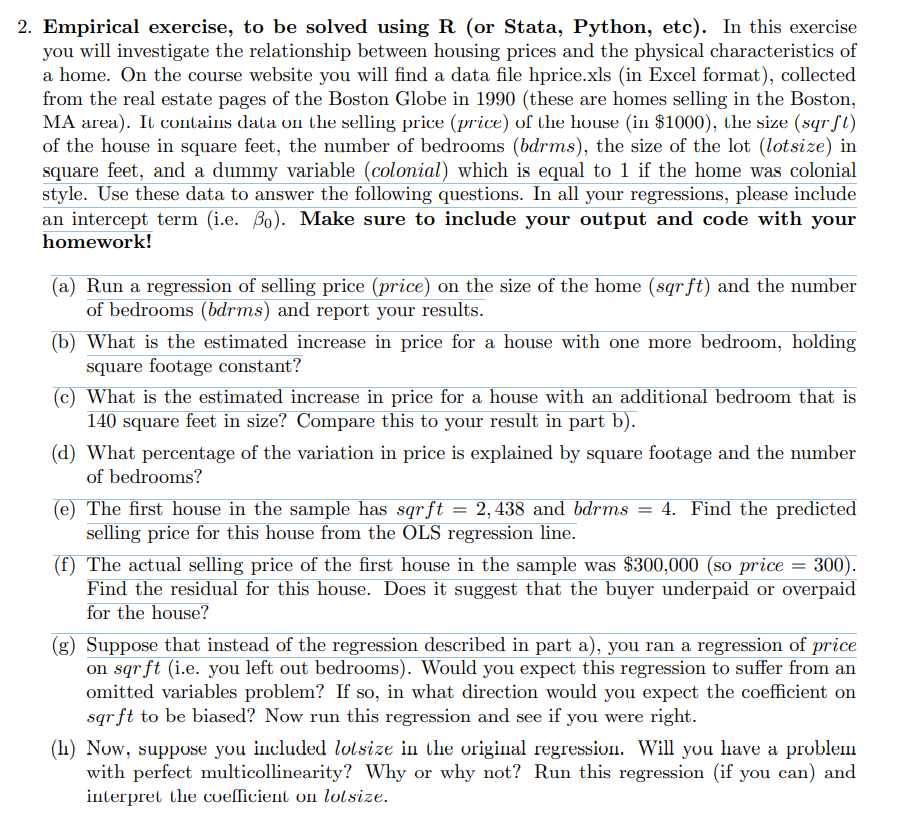
2. Empirical exercise, to be solved using R (or Stata, Python, etc). In this exercise you will investigate the relationship between housing prices and the physical characteristics of a home. On the course website you will find a data file hprice.xls (in Excel format), collected from the real estate pages of the Boston Globe in 1990 (these are homes selling in the Boston, MA area). It contains data on the selling price (price) of the house (in $1000), the size (sar Sl) of the house in square feet, the number of bedrooms (bdrms), the size of the lot (lotsize) in square feet, and a dummy variable (colonial) which is equal to 1 if the home was colonial style. Use these data to answer the following questions. In all your regressions, please include an intercept term (i.e. Bo). Make sure to include your output and code with your homework! (a) Run a regression of selling price (price) on the size of the home (sqr ft) and the number of bedrooms (bdrms) and report your results. (b) What is the estimated increase in price for a house with one more bedroom, holding square footage constant? (C) What is the estimated increase in price for a house with an additional bedroom that is 140 square feet in size? Compare this to your result in part b). (d) What percentage of the variation in price is explained by square footage and the number of bedrooms? (e) The first house in the sample has sarft = 2,438 and bdrms = 4. Find the predicted selling price for this house from the OLS regression line. (f) The actual selling price of the first house in the sample was $300,000 (so price = 300). Find the residual for this house. Does it suggest that the buyer underpaid or overpaid for the house? (g) Suppose that instead of the regression described in part a), you ran a regression of price on sqrft (i.e. you left out bedrooms). Would you expect this regression to suffer from an omitted variables problem? If so, in what direction would you expect the coefficient on sarft to be biased? Now run this regression and see if you were right. (1) Now, suppose you included lolsize in the original regression. Will you have a problem with perfect multicollinearity? Why or why not? Run this regression (if you can) and interpret the coefficient on lolsize. 2. Empirical exercise, to be solved using R (or Stata, Python, etc). In this exercise you will investigate the relationship between housing prices and the physical characteristics of a home. On the course website you will find a data file hprice.xls (in Excel format), collected from the real estate pages of the Boston Globe in 1990 (these are homes selling in the Boston, MA area). It contains data on the selling price (price) of the house (in $1000), the size (sar Sl) of the house in square feet, the number of bedrooms (bdrms), the size of the lot (lotsize) in square feet, and a dummy variable (colonial) which is equal to 1 if the home was colonial style. Use these data to answer the following questions. In all your regressions, please include an intercept term (i.e. Bo). Make sure to include your output and code with your homework! (a) Run a regression of selling price (price) on the size of the home (sqr ft) and the number of bedrooms (bdrms) and report your results. (b) What is the estimated increase in price for a house with one more bedroom, holding square footage constant? (C) What is the estimated increase in price for a house with an additional bedroom that is 140 square feet in size? Compare this to your result in part b). (d) What percentage of the variation in price is explained by square footage and the number of bedrooms? (e) The first house in the sample has sarft = 2,438 and bdrms = 4. Find the predicted selling price for this house from the OLS regression line. (f) The actual selling price of the first house in the sample was $300,000 (so price = 300). Find the residual for this house. Does it suggest that the buyer underpaid or overpaid for the house? (g) Suppose that instead of the regression described in part a), you ran a regression of price on sqrft (i.e. you left out bedrooms). Would you expect this regression to suffer from an omitted variables problem? If so, in what direction would you expect the coefficient on sarft to be biased? Now run this regression and see if you were right. (1) Now, suppose you included lolsize in the original regression. Will you have a problem with perfect multicollinearity? Why or why not? Run this regression (if you can) and interpret the coefficient on lolsize







